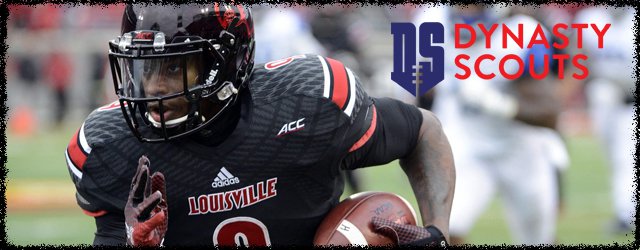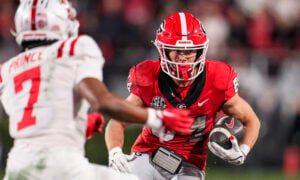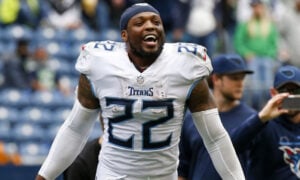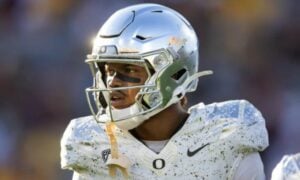Pre-Combine Questions and Assessments

Editor’s Note: This is a Dynasty Scouts exclusive article. Remember, our Dynasty Scouts section focuses on the stars of tomorrow, with a laser focus on High School recruits and College players who look to have the talent to be future assets in dynasty leagues and have value today in devy leagues. Dynasty Scouts articles are found in our Premium Content.
Unless you live under a rock, you know that the NFL Combine starts this week and many questions will be answered. It’s possible that many more will arise.
Each season, college football’s most talented descend on Indianapolis to run a designated series of drills in hopes of raising their draft stock and impressing NFL brass. While opinions differ widely as to the ultimate usefulness of this, as Mike Mayock calls it, “Underwear Olympics,” there are still many measurables that should have bearing on the draft stock of the participants. Certain traits such as height, weight, hand size, arm length cannot be faked, nor taught. Once within the actual drills, the vertical jump, broad jump, cone drills, bench press and 40 times still give measurements that serve to further stratify the athletes. When it’s all said and done, the debate as to whether the latter measurables portend any level of greater success in the NFL will rage on.
For fantasy players and especially those of us partial to the dynasty format, the NFL Combine is nearly as exciting as a new league draft.
I do listen closely to the talking heads as we approach the Combine – it’s all useful information to take note of, but as I’ve cautioned DLFers for as many years as we’ve been around, take nothing as gospel and do your own due diligence. f you don’t have the time, desire or skill, then at least hitch your wagon to those that you have come to trust and those that have a historical level of accuracy. No single scout, be they professional or of the armchair variety, will approach a 100% ‘hit’ rate on prospects. Over time, those that are deserving of your time will rise to the top. When looking around our industry, I would urge you to be a very discerning critic as there is a lot of parroting going on.
[am4show have=’g1;’ guest_error=’sub_message’ user_error=’sub_message’ ]
A little bit about my scouting philosophy and tendencies: I always remain completely objective. With each new play that I watch during my film review, I try to reset my pointer and score. I work very hard to see beyond the simple parroting of others’ information or scorecard and make my own assessments when looking at the rookies. It’s all too simple to listen to the talking heads, adopt the same view and call it your own. As dedicated to our readers as we are here at DLF, you deserve independent analysis.
When reviewing different positions, I use different scorecards and look for different facets of performance. For running backs, I may look for hip-swivel (my own term), squared and angular agility and power, vision, lateral agility, running height, hands and a dozen other characteristics. For receivers, I focus more on explosion off the line of scrimmage, stemming and breaks out of routes, suddenness, vertical leaping (high-pointing), body usage, catch technique, speed, intelligence, in addition to a host of other items. For all positions, I evaluate size and measurables for what I’ve found to be the ‘hot zone’ for successful players. Combine all of this data with performance versus opponents and strength of schedule and you begin to get a clearer picture of the player’s potential. You get the idea.
The key point in my reviewing is that I put in many hours of my own work and rank accordingly. I vehemently resist the temptation to follow common thought or be a lemming. Our rankings following the Combine will be very preliminary and subject to change as we continue to measure the data and watch film. Personally, when I find myself on an island in comparison to popular opinion on a player, I spend more time in film review session where I second-guess and reassess my own findings.
Believe it or not, the due diligence that we do as amateur scouts tends to pay off more in the second and third rounds, especially the third. The top 12 players each year can be very close in value while spanning multiple tiers. Depending on the class, this starts to thin out as we enter the mid second round. I have personally found that my assessment skills tend to yield great receiving prospects in the third round, while uncovering good potential in the second round. Simply put, by knowing more than your fellow coaches as the player pool thins out, you are in a unique position to identify talent that may not have fallen to the best team/situation and, while others are picking higher profile situations and names, you can strike at the best talent.
As I’ve stated in previous 2015 rookie pieces, this class appears to be very deep at both receiver and running back. With no running backs selected in the first round in both 2013 and 2014, the position has lost some of its luster. 2015 has the potential to apply a new shine. This year’s incoming receiver class looks to maintain the momentum of recent years in which there has been a greater ratio of success by early-round players. The new-look NFL emphasizing the passing game seems to have spawned a greater number of large receivers with the height/weight/speed ratio to become early-career impact players. If there’s been a lackluster position in fantasy drafts, it has been the quarterback. Save generational names such as Andrew Luck, even the most gifted of quarterbacks entering as rookies are falling in rookie drafts, often times into the second round.
Here are some of my assessments and things that I’m specifically looking for in this year’s Combine.
1.) Amari Cooper, WR Alabama – What is his measured size?
There’s no doubt when watching Cooper that he has the intelligence, dynamic and skills-set to be a NFL difference-maker in year one. I don’t expect incredible production, much like 2014’s Sammy Watkins, but he’s going to be a good receiver. My question regarding Cooper surrounds that of his height. Listed at 6’1” and 210 pounds, my feeling is that he’s closer to 6’, perhaps even less. This isn’t a huge issue if for any other reason than I do prefer larger receivers. Receivers such as Antonio Brown, Marvin Harrison, TY Hilton, Jeremy Maclin and others have proven to be top producers, but larger receivers more often grace the top of rankings. After reviewing tape of both Cooper and Louisville’s DeVante Parker, they are different receivers, each with their own stark benefits. I have both neck and neck in my rankings and a slight breeze could sway my rankings as my review goes on.
2.) Jay Ajayi, RB Boise State – What is his 40 time?
I’ll admit that Ajayi had drifted lower on my board until I was well within my tape review. After multiple sessions, he now sits at a tenuous RB3 ranking on my board, after Melvin Gordon and Todd Gurley. The sexy comparison I’ve heard with Ajayi many times in the past month has been to none other than Marshawn Lynch. After multiple film sessions watching Ajayi, in addition to tape of Lynch while still at Cal, I have concluded that those making the comparison are looking too much at Ajayi’s hair than they are at running style.
That said, early in my review I did see some consistent space-movement traits, those characteristics used by backs before first contact. Further review however, leads me to not draw enough similarity to make the comparison. To Ajayi’s credit, he is more fluid than was Lynch. Lynch’s game now, is far more powerful than while at Cal. His running style is never truly fluid. Ajayi also appears to be more comfortable with his hands on the move. But, in conclusion, while speed is not the end-all for running backs, it does play a role. There isn’t a lot of wasted movement in Ajayi’s style, which bodes well for his transition to the NFL and he possesses a very nice hesitation move. In the NFL though, one must capitalize on space when it is created and I question Ajayi’s speed to that space, as he does tend to bounce too many runs to the outside. Lastly, there’s the issue as to competition level. Boise State numbers do not equate to other major conference numbers. As for his speed, give me 4.52 or better to remain highly interested.
3.) Mike Davis, RB South Carolina – Size and Speed?
Like most wannabe scouts, I do like to hang comparisons on players while I watch them on tape. I’ve heard many talk about Davis but none mention the comparison to Michael Turner. Davis reminds me a LOT of Turner. He’s a downhill runner with the size and lower body to punish poor-foundation tacklers. He’s got just enough wiggle on his first cut to use his size to his advantage and gain leverage into the second level. Beyond that, it’s all power and open space. The Turner comparison should elicit some favorable response as well as negative. It’s very difficult to project a back like Davis into the NFL and see significant fantasy upside. Much will come down to system and the presence of complementary backs. To his credit, he is reasonably adept and playing a role in the passing game. I’d like to see Davis come in below his listed 223 pounds and run a sub 4.6 40. Even with that, most will likely remain higher on his prospects than I.
4.) Ameer Abdullah, RB Nebraska – Size and Speed?
Abdullah is in an interesting position heading into the Combine. Hype for the diminutive runner is cresting and in mock drafts we’ve seen him taken at #3 overall. I don’t expect to see much from the Combine that would affect my view of him, unless he were to weigh in closer to 200 pounds and I suspect it will be less than his listed weight of 195. He catches the ball well, is dynamic with the ball in his hands unlike any other back in this class, is of ultra-high character and it’s very easy to see why so many are so intrigued. At the same time, he also fumbles at an alarming rate, is undersized and there’s little way that he’ll be a feature back at the next level. He’s easy to root for but what you see on tape is all he is and there’s little to be learned from the combine other than his physical measurable and long speed. He’ll be perhaps the wildcard first round rookie pick in fantasy drafts.
5.) DeVante Parker, WR Louisville – Can he put on a clinic and overtake Cooper?
I can’t say enough about what I’ve seen on Parker. I waited some time before watching his tape so that I could fully understand Cooper’s tangibles and game. After watching Parker, I can’t say enough how close he is to overtaking Cooper as my WR1 in this class. Parker can do it all – and well. I’ve watched a lot of receiver film over the years and I don’t think I’m in the dark when I say that Parker may be the best high-point receiver that I’ve seen yet. Combine that with an elite catch radius and you have the makings of a ultra-dynamic WR1 in the NFL. Parker catches everything in sight and is nearly flawless in his catch setups, which provide a foundation for leaping to high point an incoming ball, establishing maximum leverage. In space, he gets to top speed quickly and can long stride away from defenders. If he runs anywhere close to a 4.40 in the 40, it’s game on as first receiver off the board against Cooper.
6.) Dorial Green-Beckham, WR Oklahoma – Character vs. Talent on Display?
Want another wildcard selection in upcoming fantasy drafts? Enter troubled receiver Dorial Green-Beckham (DGB). Many professional scouts label DGB as the most talent-rich receiver in the 2015 class. I’ve watched film, back to back, on both DGB and Parker to best ascertain their skillsets when compared to each other. There are a lot of similarities, but DGB is still a measure behind Parker in my mind. Factor in the character issues and you’ve got a noteworthy risk-reward scenario. On film, DGB doesn’t have the same consistent high point leaping than that of Parker, but he’s not far off. His open field dynamic is also not up to Parker’s levels, but I seem to be in the minority in this analysis. As mentioned above, this means I will be watching more tape on DGB to ensure my assessments are correct, at least in my view. For the Combine, I’m very much looking forward to getting a look at DGB, his long speed, hand size and arm length. Beyond that, I’ll be looking for a comparative analysis with that of Parker.
7.) Quarterbacks – Do they throw?
If there’s a positive movement to be had as we head into the Combine, it’s in the fact that it appears, at least at this point, that both Marcus Mariota and Jameis Winston are going to throw. With a poor rate of top-tier passers making the choice to throw in recent years, this is a very positive development. As mentioned previously, quarterbacks in dynasty drafts are falling with increased velocity and this year doesn’t appear to contain a passer that will buck that trend. Both Mariota and Winston are very different quarterbacks, both with their own red flags. I do believe both can make all the NFL throws. Winston appears to be the top passer on the board and likely to be selected first overall, but Mariota is sure to impress in interviews and on the chalkboard. Either way, with both participating in drills, it will bring an added level of intrigue to the Combine and I’m looking forward to seeing how they perform.
8.) Devin Smith, WR Ohio State – Does he blaze a new 40 best?
It seems that Smith is rising up boards quickly based on the belief that he’s capable of blazing a 40 yard dash in the low 4.20s. If that’s the case, he’ll help his draft stock and, likely, his fantasy stock to a larger degree. I’ll be watching with great interest but more as an exercise to see what becomes of his draft stock following a fast time. I’ll likely be staying away from the burner as I haven’t seen anything on tape that suggests he’s anything more than a high-speed raw prospect. Typically, speed receivers need a lot more than a set of wheels to make it in the NFL. Names in the past such as Troy Williamson (2005), Darrius Heyward-Bey (2009) and Stephen Hill (2012) all blazed fast 40s and were overdrafted in the NFL but flamed out in fantasy. Is Smith the next?
9.) Kevin White, WR West Virginia – Can he run a fast 40?
It’s arguable what constitutes a “fast 40”. For White, the one-year standout with exceptional size (6’3”/211 pounds), speed hasn’t defined his collegiate career. A two year Mountaineer after spending his first two years as a junior college transfer, White only had one ultra productive season where he reeled in 109 receptions for 1,447 yards and ten touchdowns. He also displayed a blended dynamic of size, ball skills and enough speed to get the job done. The question isn’t about game speed, but timed speed. Mike Mayock believes he could be the first receiver off the board if he can run a 4.45 in the forty. I don’t believe White can accomplish that task nor do I believe he needs to. His game isn’t speed dependent and while it will help his draft stock, White shows skill and purpose in all phases of his receiving game such that a 4.55 would provide upside and tangible speed to secure a top selection. Drawing comparisons to Larry Fitzgerald in some circles, who himself ran a slower 40, White has a lot to earn come Saturday if he can pull it off. Either way, he’s a first round selection. Even with a fast time, I won’t be placing him above Cooper or Parker.
10.) Jeremy Langford, WR Michigan State – Can he climb into late first round (fantasy) discussion?
Langford is one of my favorite sleepers from this year’s class. While I have a lot more tape to watch of him, I’ve seen enough to know that he offers fantasy owners a lot of upside given where he will be drafted in the NFL. He’s not dynamic enough to make a run for a bell-cow back early in his career but he’s got the size and frame to add weight (6’1”/208) and strength to his game. Langford is one of those backs that would do well to come in well short of his 6’1” listed height while maintaining his weight. At 5’11” and change in the 205+ pound range, he makes for an intriguing upside sleeper as he’ll add ten pounds in the NFL. He’ll look to run in the 4.40s and I’ll be watching his shuttle drills for displayed agility but his tape review shows enough to grant attention. A five year player for State, including a red-shirt 2010 campaign, he’s already 23 years of age. I don’t believe Langford can sneak into the first round of fantasy drafts, largely due to his age given his running back position, but I’m looking for a solid Combine to raise awareness.
11.) Who is this year’s “Workout Warrior”?
Every year has a name that leaps off the page and into early-draft discussion. That is not to say that they don’t pan out but, in most cases, they fall back into anonymity almost as quickly as they rose from it. Keep an eye on the 40 times to locate 2015’s warrior. My prediction is Florida State’s running back, Karlos Williams.
Hope you enjoyed a quick look at some of those items I’ll be specifically watching. If you have your own, please share them below.
Follow me on Twitter: @DLF_Jeff
[/am4show]
- Lineup Advice: Wrap-up, Thank You and Goodbye (TTFN) - January 1, 2024
- Lineup Advice: Week 17 – Championship Edition - December 26, 2023
- Lineup Advice: Week 16 – The “What is” Edition - December 19, 2023


































































